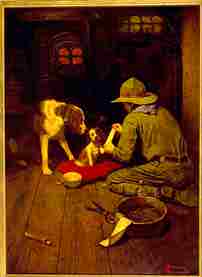BSA Historical Highlights - 1910's
1910s | 1920s | 1930s | 1940s | 1950s
1960s | 1970s | 1980s | 1990s | 2000s
- 1910
- The Boy Scouts of America was incorporated on February 8 under the laws of the District of Columbia by W. D. Boyce. On June 21, a group of 34 national representatives of boys' work agencies met, developed organization plans, and opened a temporary national headquarters in a YMCA office in New York. In September, Robert S. S. Baden-Powell, the founder of Scouting, visited America and interpreted the program. President William Howard Taft accepted the office of honorary president; Theodore Roosevelt became honorary vice president and chief Scout citizen; Colin H. Livingstone was elected president; Mortimer L. Schiff, Milton A. McRae, and Benjamin L. Dulaney, vice presidents; George D. Pratt, treasurer; Daniel Carter Beard, National Scout Commissioner; Ernest Thompson Seton, Chief Scout; and John Sherman Hoyt, Jeremiah W. Jenks, William D. Murray, and Frank Presbrey, members of the Executive Board. James E. West was appointed executive officer.
- 1911
- The National Council office was established at 200 Fifth Avenue, New York, N.Y., on January 2, 1911, with seven employees. The first annual meeting was held at the White House, Washington, D.C., and was addressed by President Taft. The Scout Oath, Law, badges, and fundamental policies were adopted. The first awards for heroism were presented by the National Court of Honor. Membership to date, Scouts and Scouters, 61,495.
- 1912
- By now Scouts were enrolled in every state. Scouts mobilized for the first of a series of national civic Good Turns, including the promotion of a safe and sane Fourth of July. Other community Good Turns began. Sea Scouting for older Scouts was started. Boys' Life was purchased to become an official BSA magazine. Membership during the year, Scouts and Scouters, 97,495. Total members to date, 126,860.
- 1913
- The first local council charters were issued to first-class and second-class councils. Local supervision was facilitated by dividing the United States into eight districts—the forerunner of 12 regions. Scouting, the official magazine for Scouters, was started. Boy Scout Week was observed. A registration plan for Scouts was adopted. Scouts demonstrated the motto "Be Prepared" in first aid during spring floods in Ohio and Indiana. Scouts rendered service at the 50th anniversary of the Battle of Gettysburg reunion of veterans. The first Children's Book Week was observed. Membership during the year, 115,364. Total members to date, 188,964.
- 1914
- The troop committee plan was created. The first Scout Sunday observance took place. Training for Scout leaders was developed. The first William T. Hornaday gold medal for the conservation of wildlife was presented. The first tree-planting project was held in New York. Membership, December 31, was 127,685. Total members to date, 275,304.
- 1915
- The Department of Education established a national office to train all Scouters. Expansion of merit badge work prompted issuance of 57 merit badge pamphlets. The Handbook for Scoutmasters was issued. Military policy was adopted. Scouting was extended on the Pacific coast. The Order of the Arrow was founded. Membership, December 31, was 182,303. Total members to date, 409,662.
- 1916
- Congress granted a Federal Charter on June 15, giving special protection to the name and insignia and limiting membership to American citizens. An act of Congress, June 3, authorized a Scout uniform similar to the Army, Navy, or Marine uniform. The Constitution and Bylaws were adopted. The first college course in Scouting was held at Teachers College, New York. Veteran and associate Scout classifications were created. Scouting in rural areas emphasized Pioneer Scouts (later Lone Scouts). A Department of Camping was established at the national office to help local councils maintain camping standards and promote camping. Membership, December 31, was 245,183. Total members to date, 571,649.
- 1917
- Scouting's full resources were placed at the service of the government, under the slogan "Help Win the War," and, within 24 hours, Scouts throughout the United States were so advised. Significant demonstration of boypower, trained and organized for service, followed for the duration of the war and drew thousands of boys into the movement. The first winter camp was held by Chicago Scouts. Membership, December 31, was 363,837. Total members to date, 812,586.
- 1918
- After the signing of the armistice, the slogan "The War Is Over, but Our Work Is Not" was adopted. Scouts rendered nationwide service during the influenza epidemic. The first service club sponsorship of troops was inaugurated by Rotary International. A Scout executives' training conference was held at Cranberry Lake. National standards were established for Boy Scout camps. As part of the war effort, 1917-18, Scouts sold 2,350,977 Liberty Loan bonds, totaling $147,876,902; war savings stamps, to a value of $53,043,698. More than 300 million pieces of government literature were distributed, and services rendered included food and fuel conservation and Boy Scout war gardens. Membership, December 31, was 418,984. Total members to date, 1,065,495.
- 1919
- A systematic method of developing cooperation with churches of all faiths was adopted. Boy Scouts were invited to aid the Department of Labor in its Americanization program. Following the death of Chief Scout Citizen Theodore Roosevelt on January 6, Scouts began the practice of planting Roosevelt memorial trees and making pilgrimages to his grave at Oyster Bay. The first gold Honor Medals were awarded by the National Court of Honor for saving life at risk of the rescuer's own, replacing the silver and bronze awards. Membership, December 31, was 462,060. Total members to date, 1,325,878.